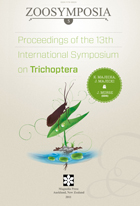Abstract
The diet of 4th and 5th instar larvae of filter-feeding trichopteran species [Hydropsyche contubernalis McLachlan, H. modesta Navás and H. pellucidula (Curtis)] that are dominant in the benthos in riffle habitats was analysed. Caddisflies were collected in a river section downstream of a dam. Samples were collected in 2 periods: S1—during the functioning of the dam reservoir, and S2—just after it was emptied (reservoir recovery). Gut contents were examined from the anterior part of the alimentary canal. Formless content, diatoms and other algae were considered as detritus. The diet of 4th instars mostly consisted of plant and animal detritus, with a small contribution of early stages of Chironomidae larvae. In contrast, 5th instars consumed larger chironomids in the subfamilies Orthocladiinae and Tanytarsini. When the reservoir was emptied, an increase in the contribution of invertebrates to the diet was observed – chironomid larvae, trichopterans and ostracods dominated. In spring they were Chironomidae (Cricotopus sp.), while in winter and summer Simuliidae. The most diversified diet was recorded in H. contubernalis and H. modesta in the summer of S2. Trichopteran secondary production in the investigated river section was similar in both study periods: 38.8 in S1 and 35.3 g dry mass m-2 year-1 in S2. In both study periods, the highest values of production were recorded in the stony riffle habitat, where H. contubernalis comprizeded 23.4% (S1) and 18.8% (S2) of total annual trichopteran production originating from all the investigated habitats.

